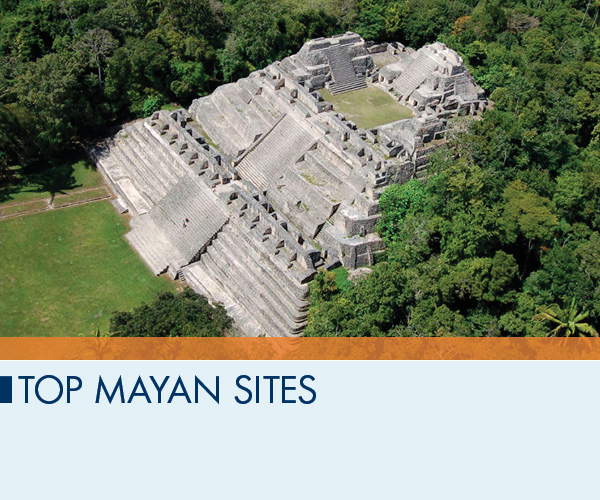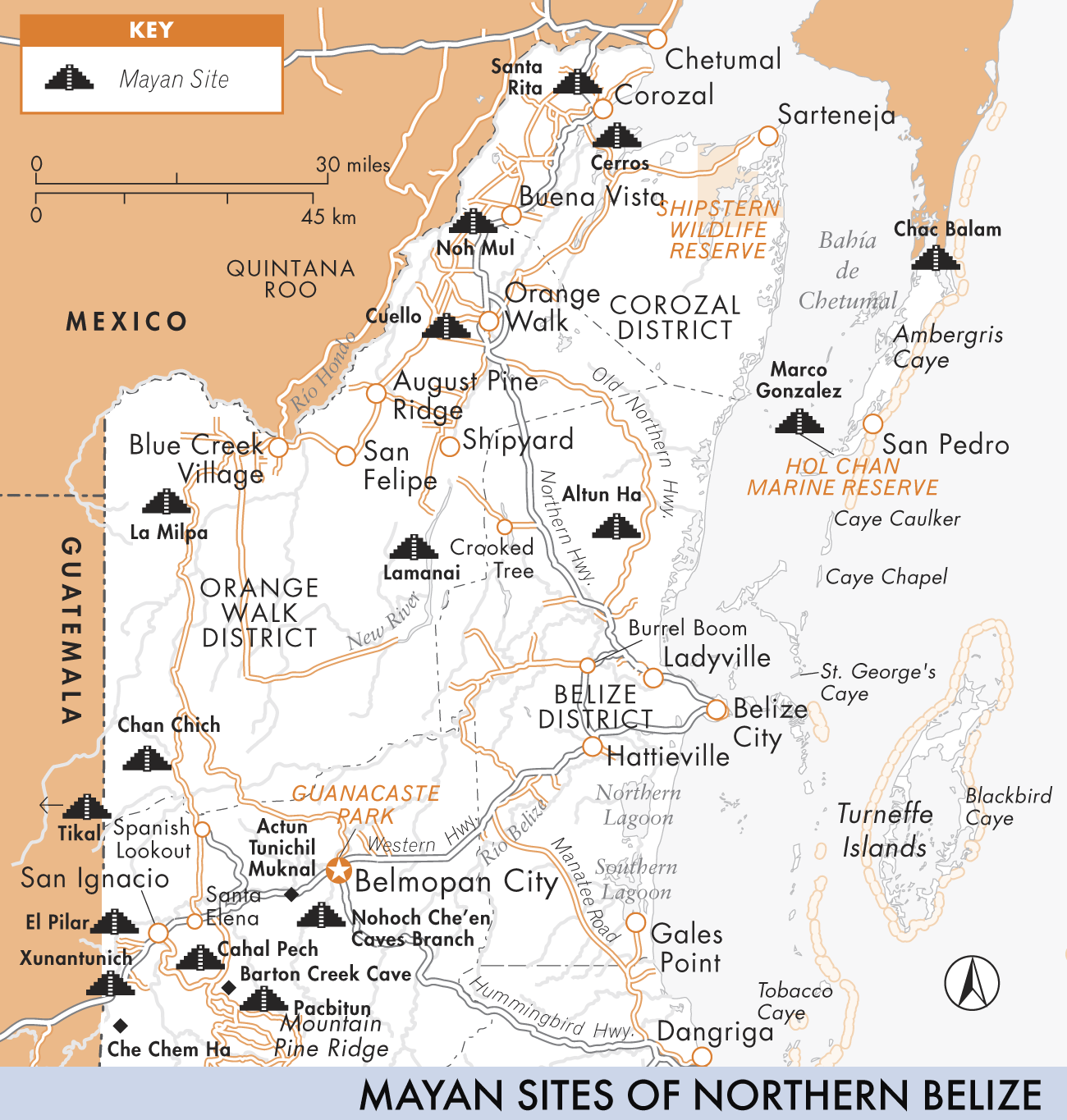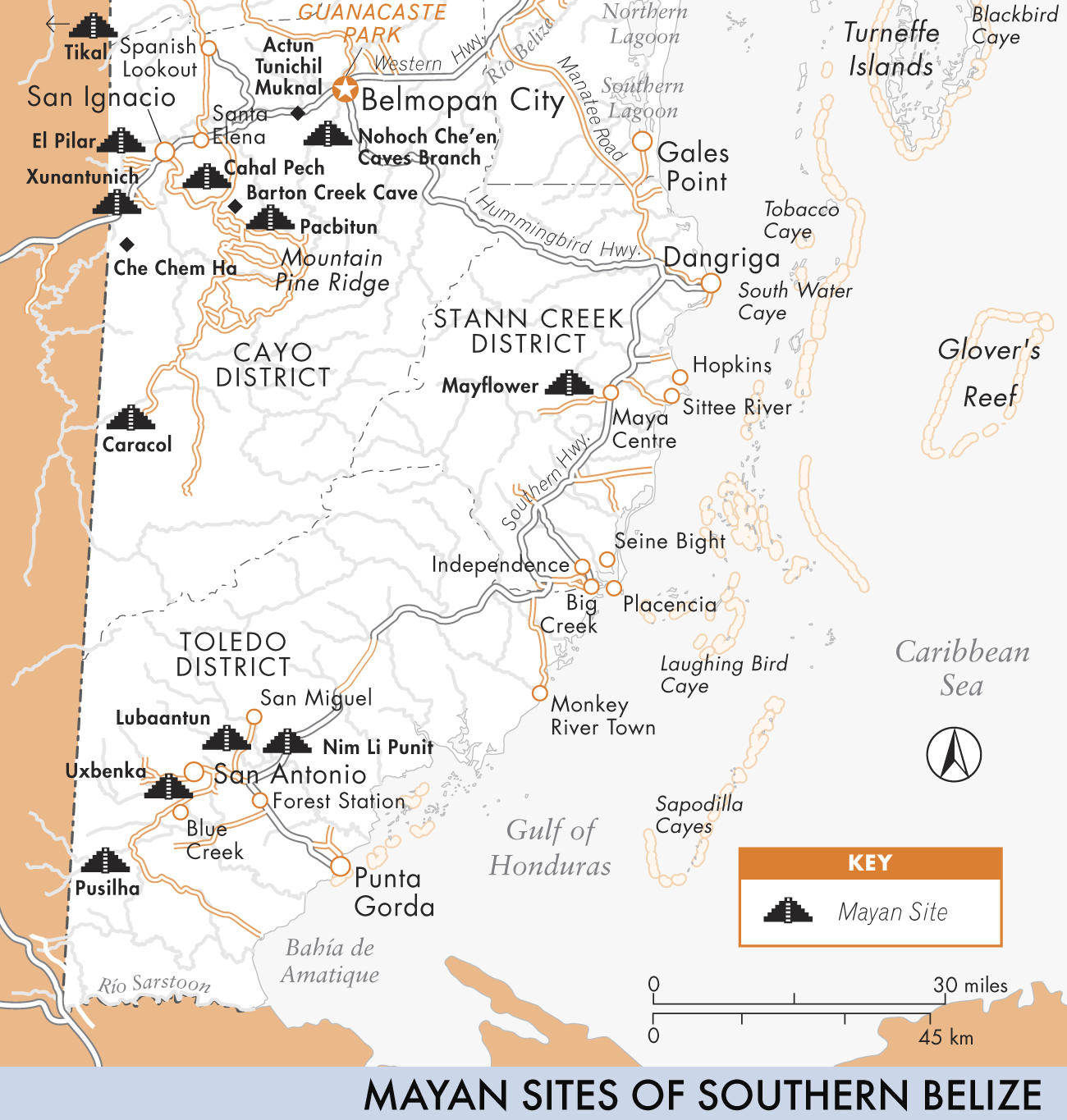
Previous Chapter | Next Chapter | Table of Contents
The following are our picks for the most notable Mayan sites in BelizeFees at most sites for non-Belizeans are BZ$10–BZ$20, and Actun Tunichil Muknal is BZ$50. As of this writing, a scheduled admission increase to some Mayan sites has yet to be implemented—ask locally. Admission fees are in addition to any fees for guides or tours.
Northern Belize
Altun Ha. The most visited Mayan site in Belize, though not the most impressive, is popular with cruise-ship passengers and for those staying on Ambergris Caye or Caye Caulker. It’s a little more than an hour’s drive north of Belize City. One of the temples at Altun Ha is prominently pictured on Belikin beer bottles.
Cerro Maya. Although the few remaining original structures here are weathered, and there’s no museum or visitor center, Cerro Maya—like Tulum in the Yucatán—enjoys a glorious location right beside the water.
Chan Chich. The lodge of the same name was built literally on top of this minor ceremonial site. It can be reached by car or charter flight and is best visited in connection with a stay at the lodge.
Cuello. It’s one of the oldest Mayan sites in the region, settled more than 2,500 years ago. It’s on the property of a rum distillery near Orange Walk Town, and you have to get permission in advance to visit it.
Marco Gonzalez. This 2,100-year-old site on the southern end of Ambergris Caye, 5½ miles (9 km) south of San Pedro, is the first Mayan site national park on a Belize island. Today the site is mostly unexcavated, but there are plans for a new education and visitor center. Access to the site is via a rough boardwalk over mangrove swamp—bring lots of mosquito spray!
La Milpa. The third-largest Mayan site in Belize (only Caracol and Lamanai are larger), La Milpa is in the early stages of exploration and excavation. It can be visited through advance arrangement with Programme for Belize, on whose land it sits.
Lamanai. Boat your way up the New River to the shores of the New River Lagoon to see this ruin, which has the most beautiful setting of any Mayan site in Belize. You also can reach it by road from Orange Walk Town. Lamanai has a small museum and a resident troop of howler monkeys.
Santa Rita. Corozal Town is built on what was the large Mayan trading center known as Chactemal (or Chetumal, as the capital of Quintana Roo, Mexico, is known today). A part of the ruins, now called Santa Rita, is on a hill on the outskirts of Corozal. The Belize government is trying to promote Santa Rita by transforming it into the “Official Mayan Wedding Garden of Belize.”
The Cayo
Actun Tunichil Muknal. “ATM,” near Belmopan, provides the most rewarding Mayan cave experience in Belize, and indeed in the entire region. Many visitors say it is the highlight of all their travels in Central America. To see the cave, you have to take a 45-minute hike and a brief swim, and be a part of a guided tour. Only about 30 guides are certified to lead trips to ATM. Photography is no longer permitted.
Barton Creek Cave. You can canoe through part of this 7-mile (11-km) wet-cave system once used by the Maya for human sacrifices. It’s about a half hour off the Chiquilbul Road on the way to the Mountain Pine Ridge.
Cahal Pech. This small Late Classic site, with a lovely location on a hill overlooking San Ignacio, is easily accessible from town. It has a little museum.
Caracol. The largest and most significant site in Belize is a must if you’re in the Cayo. It’s an all-day trip from San Ignacio through the Mountain Pine Ridge, but it’s well worth the time. There’s a museum and visitor center, and extensive excavations have been underway for more than 30 years.
Che Chem Ha. This cave on private land south of Benque Viejo has artifacts dating back 2,000 years.
El Pilar. Set on low hills above the Mopan River at the Guatemalan border is one of the largest sites in Belize, but little of it has been excavated.
Pacbitun. Near San Antonio village on the road to the Mountain Pine Ridge, Pacbitun dates back to at least 1000 BC. It’s on private land.
Xunantunich. Though it’s not one of the largest sites in Belize, Xunantunich is one of the easiest and most pleasant to visit. To reach it, you cross the Mopan River on a quaint, hand-pulled ferry. There’s a well-done museum and visitor center. It’s off the Western Highway, west of San Ignacio.
Southern Belize
Lubaantun. Occupied for less than 200 years in the Late Classic period, Lubaantun is unusual in that no stelae were ever found here, and the precisely fitted building stones, laid without mortar, have rounded corners. The controversial “Crystal Skull” supposedly was found here. Lubaantun is near San Pedro Columbia village, about 20 miles (32 km) from Punta Gorda.
Mayflower. This Classic-period site, off the Southern Highway just south of Dangriga, is in the early stages of excavation. Waterfalls nearby make the setting appealing.
Nim Li Punit. Off the Southern Highway north of Punta Gorda is Nim Li Punit (“Big Hat” in Ketchi), a small but pretty site. There’s a visitor center.
Pusilha. At a site near Aguacate Village on the Moho River is this collection of extensive but low-lying structures on a small hill. Also visible are the remains of a stone bridge. It is officially closed to the public, though you can ask locally to see it. Because of its remote location off the main highway, there aren’t many visitors who make the trip out here.
El Petén, Guatemala
Tikal. Along with Copán in Honduras and Palenque in Mexico, Tikal is considered by many to be the most impressive of all Mayan sites. The Petén area is home to several other ruins, including Nakúm, El Ceibal, Uaxactún, Yaxhá, Yaxchilán, El Zotz, and El Mirador. Some, like El Mirador, are extremely remote, requiring a multiday jungle trek.
Previous Chapter | Beginning of Chapter | Next Chapter | Table of Contents

